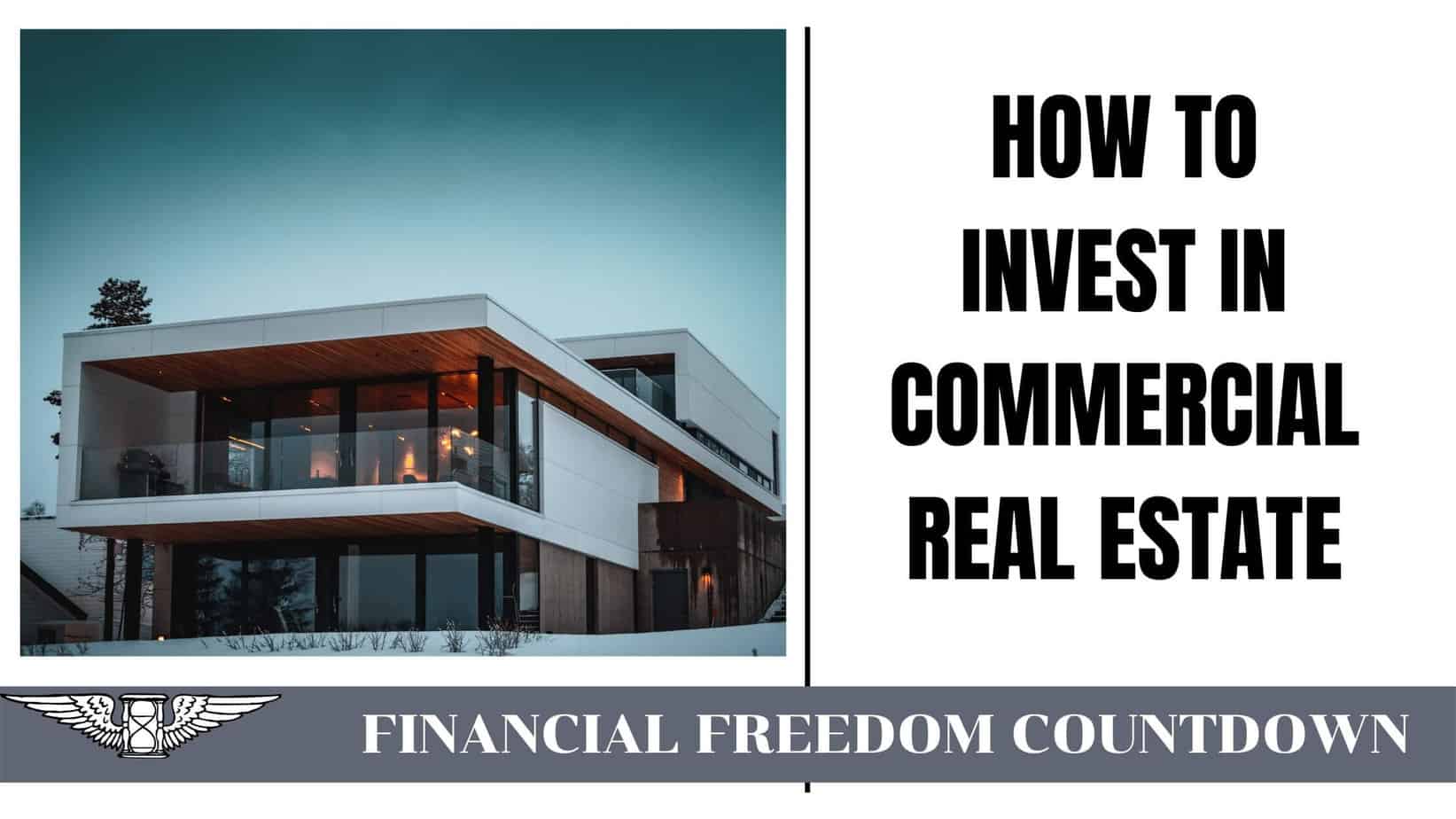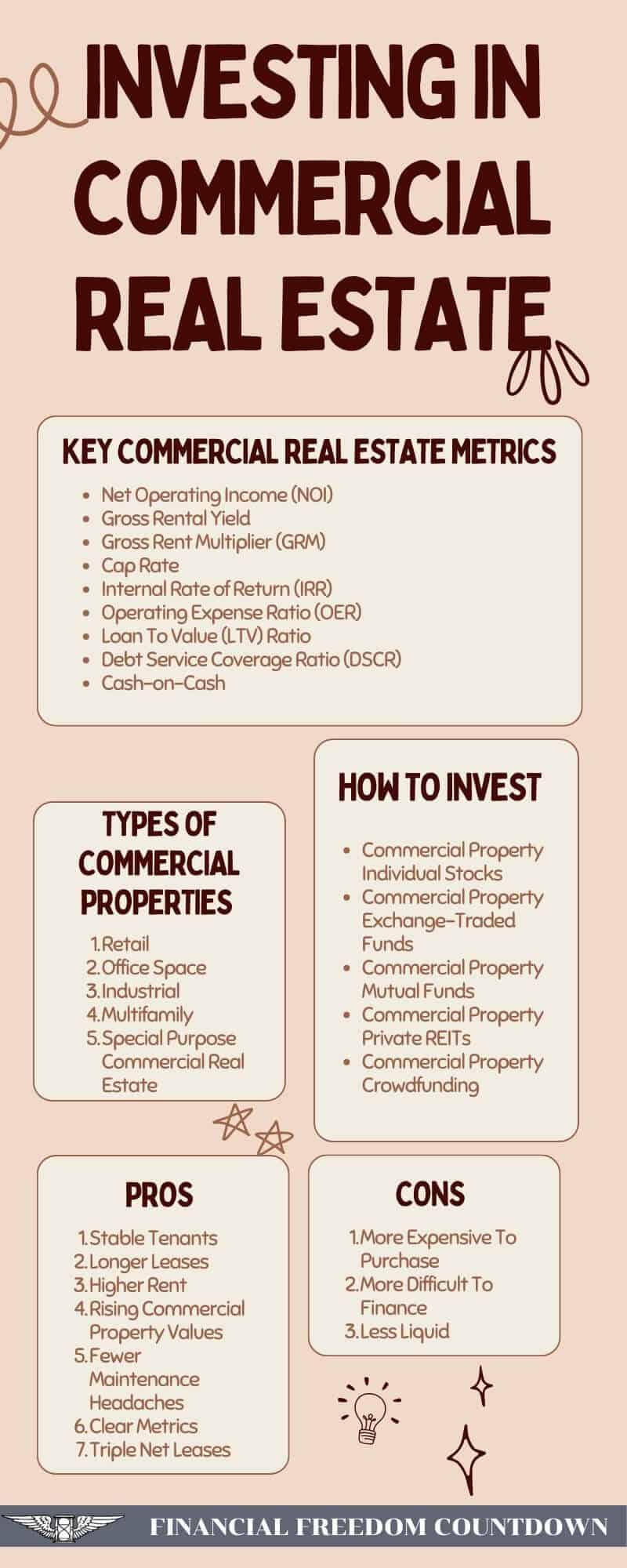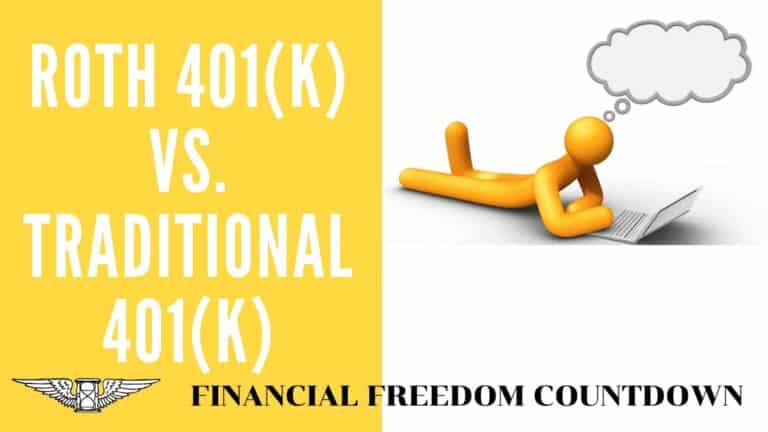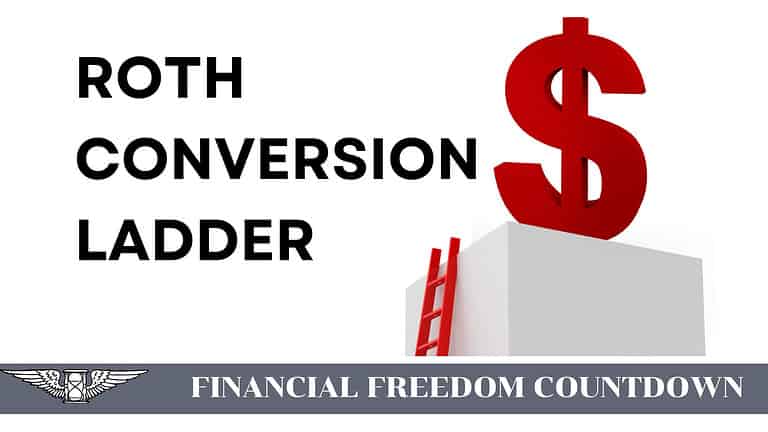How To Invest in Commercial Real Estate: 5 Ways To Get Started

Many investors seek to broaden their portfolio of investments after getting started with real estate investing. Commercial real estate investing is one area that can diversify a portfolio and increase profits and cash flow. With an increased cash flow, investors enjoy more passive income they can use towards other financial goals.
If you’re already invested in residential real estate and residential properties, expanding into commercial real estate can be a smart move. Over the years, commercial real estate investing has generated some of the highest income streams for landlords.
Although commercial real estate can be a great way to invest your money and secure your financial future, ensuring you’re making a suitable investment is essential. With so many income-producing assets available, it can be hard to know where to start.
We will cover the pros and cons and how to invest in commercial real estate.
Is Now a Good Time To Invest in Commercial Real Estate?
Some residential real estate investors have been reluctant to expand into commercial real estate because of the recent pandemic and the negative news surrounding commercial property.
Many businesses closed their doors or reduced their hours, which limited income, forcing many to close for good during the lockdowns. Not only did this hurt retail business owners but commercial property owners.
The pandemic is officially over, the lockdowns have ended, and customers are again going out and shopping. It is expected that an economic recovery in commercial real estate will continue.
Industrial properties were not affected as much and continue showing increased demand. The government is also providing economic support and increased infrastructure spending, which will help commercial real estate investors.
Types of Commercial Properties To Invest In
There are five main types of commercial property in commercial real estate investing. Commercial properties come in many sizes and shapes, and investors usually pick a category they feel most comfortable with. The five main types are:
- Retail
- Office buildings
- Industrial
- Multifamily
- Special purpose properties
Retail Commercial Property
Retail commercial property includes strip malls, large shopping malls, retail centers, restaurants, banks, and more.
The pandemic has been especially hard on retail tenants and retail landlords. Bankruptcies were high among retail and department store businesses. Because of the fear of the pandemic spreading among crowds, more people turned to online shopping.
But as retail businesses transition from brick and mortar to online stores, they are expected to be replaced by grocery stores, drug stores, and restaurants. These commercial properties will not be left vacant.
As per CBRE retail report, “With grocery-based e-commerce expected to grow more than 20% in 2022 and double by 2025, grocery-anchored centers will remain the gold standard of retail investment.”
Office Space
Office spaces are the most common type. Office real estate can be as small as one office building or as large as a skyscraper.
44% percent of CBRE survey respondents expect to more than double their use of flexible office space by 2024, with the biggest adopters planning a fivefold increase.
As the pandemic continues to wane, some companies require employees to come back to work or have adopted policies requiring employees to at least show up at the office a few times per week. More employees returning to the office should stabilize office buildings and commercial real estate.
Industrial Commercial Real Estate
Industrial spaces include buildings for large manufacturing industries. They are large buildings that offer manufacturing companies with height specifications and docking availability for trucks. Industrial space is a great investment opportunity.
Industrial space also includes warehouses and is expected to be a leading performer in commercial real estate. Warehouses are not hindered by the success or failure of brick-and-mortar businesses, as online e-commerce businesses need more and more giant warehouses.
Multifamily Commercial Real Estate
Multifamily commercial real estate includes multifamily apartment buildings, high-rise condominiums units, mobile home parks, and smaller multifamily units.
A residential property having more than four units qualifies as a commercial property. A property with four or lower units qualifies as residential multifamily real estate.
The number of units in a property drives the financing eligibility matrix by Fannie Mae and is the key distinguishing factor between residential vs. commercial real estate.
Many residential property investors begin in commercial real estate when they expand into more significant multifamily real estate. The one downside over other types of commercial real estate is that residential tenants have shorter lease terms than commercial tenants in office, industrial and retail properties. In other words, the tenant turnover rate is higher for multifamily properties than for other forms of commercial real estate properties.
On a positive note, multifamily real estate offers the potential to perform “value added” real estate improvements, favorably altering the property’s cap rate.
Special Purpose Commercial Real Estate
Generally, special purpose commercial real estate properties are designed for specific uses and are not easily converted to other types of businesses.
Special purpose commercial real estate examples include gas stations, self-storage facilities, car washes, stadiums for sporting events, amusement parks, and hotels.
These types of buildings can not easily be used for a different business.
In contrast to special purpose properties, mixed-use buildings can facilitate a variety of commercial real estate on the same property. An example of a mixed-use commercial property is a building with shopping and services on the first floor and residential apartment units on the upper floors. Mixes-use commercial real estate continues to grow in popularity, especially downtown locations.
Key Commercial Real Estate Metrics
Investing in commercial real estate is unlike other investments, like buying stocks, bonds, and mutual funds. Because of this, there are some critical commercial real estate metrics that those new to commercial real estate investing should know before they begin investing in real estate. Before long, they, too, will become a seasoned investor. Most of the metrics are similar to evaluating a residential rental property.
Net Operating Income (NOI)
NOI refers to the earnings you should anticipate from a property after purchase. NOI is calculated by taking the annual income and subtracting the yearly expenses except capital expenditures and PITI payments.
NOI can assist you in standardizing a group of properties for easy comparison and help you determine whether an investment will generate enough net income to cover your monthly mortgage payments. However, you should not usually rely on NOI alone since it omits the acquisition cost, namely capital expenditures, mortgage payment, interest payment, and taxes.
Gross Rental Yield
The gross rental yield for a single property may be calculated by dividing the yearly rent collected by the total property cost. The purchase price, closing costs, and renovation expenditures are all included in the overall property cost.
Gross Rent Multiplier (GRM)
The Gross Rent Multiplier is a metric that helps investors compare properties and roughly estimate the value of a building. The property’s price is divided by its gross rental income to arrive at the figure.
Gross Rent Multiplier = Property Price or Value / Gross Rental Income
Your region and comparable houses determine a “good” GRM. The lower the GRM is, compared to other similar properties in the same market, the more appealing an investment becomes. That’s because the property generates higher gross income that can be used to pay for itself quicker than alternative homes.
Cap Rate
The capitalization rate, often known as the cap rate or net rental yield, is a better metric than the Gross Rental Yield because it factors in operating costs. You can calculate the cap rate by starting with the yearly rent and subtracting annual expenses, then dividing that by the overall property cost.
The capitalization rate is one of the most critical metrics for valuing an income-generating property because you can use it to determine market value.
Market value = Net Operating Income / Cap Rate
Assume a property will produce a Net Operating Income (NOI) of $1.5 million over the next ten years. If it were discounted at a 12% capitalization rate, the property’s market value would be $1.5M/0.12 = $12.5M.
If the real estate broker sells the property for $11.5M, it could be a great deal since you buy it below the forecasted market value based on the cap rate.
But if she offers it for $14M, you might not bid on it.
The cap rate indicates the amount of return you’ll get on a property without factoring in the financing.
In general, the higher your cap rate is, the deal has more risk. That’s because a high cap rate indicates greater profits and, as a result, increased risk. You typically see higher cap rates in risky markets versus lower caps in stable and more significant markets like New York City or San Francisco.
Constantly evaluate the cap rate in a local context instead of seeking out a reasonable cap rate.
GRM is different from Cap rate because GRM uses gross rental income while Cap rate uses Net Operating Income (NOI)
Internal Rate of Return (IRR)
The IRR is a percentage that reflects how well your investment is doing throughout its holding period. It’s the rate at which a property’s value increases over time. The calculation considers net operating income, purchase price, and long-term yield.
Set the property’s net present value to zero when calculating IRR, and use expected cash flows for each year you intend on keeping the investment properties. The net present value represents money today versus the future after it has accrued compound interest. It’s a complex calculation, so most investors use Excel’s IRR function to get the ratio.
Investors frequently utilize IRR to compare properties, but you should know its limitations. It presumes a constant rental market and no unexpected repairs. The properties you evaluate should have comparable sizes, uses, and holding durations.
IRR is another practical way to gauge whether or not a property is performing well for you.
Operating Expense Ratio (OER)
The OER is a statistic that determines how effectively you manage expenses against income. To calculate your OER, take all operating costs, deduct depreciation, and divide by operating revenue. OER is one of the most popular ratios among investors because it includes depreciation, making it more inclusive of real estate costs.
The lower your OER is, the more efficient you are at keeping costs down relative to income. If your OER is on the rise, it could be a sign of some problems.
Loan To Value (LTV) Ratio
The Loan to Value Ratio is a metric that assesses the debt on an asset. The LTV is important to borrowers because it indicates how much equity you’ll need to finance against the property’s current market value. Investors will care about this metric if you plan to operate a real estate syndication. I emphasize the LTV ratio as the primary filtering criterion in my checklist to evaluate crowdfunded real estate.
Even if you are not seeking external funding, LTV is the most reliable way to track your real estate investment equity, accounting for debt.
Debt Service Coverage Ratio (DSCR)
Another metric considered by lenders is your DSCR. It compares the amount of money you have available to service debt to your total debt burden. To compute your DSCR, divide net operating income by debt payments.
Lenders consider your DSCR while evaluating your ability to repay a new mortgage, especially in commercial real estate. A high ratio indicates that you are over-leveraged, making it more challenging to qualify for funding.
Several metrics are used to evaluate a rental property investment, and you must consider them all holistically.
When deciding whether to acquire or sell a potential property, real estate investment metrics can help eliminate any emotions from the decision. They also help track performance and identify issues before affecting your company.
Cash-on-Cash
Investors who rely on financing to buy their properties use the cash-on-cash formula. This formula compares the first-year performance of competing properties.
Cash-on-cash takes into account that the investor will not require 100% cash to buy the property but also accounts that the investor cannot keep all of the NOI or all of the future profits because part of the NOI will go towards mortgage payments and property insurance.
Usage of leverage is one of the significant reasons real estate wins when deciding to invest in real estate or stocks.
COC allows you to compare properties and evaluate performance based on money invested. When you add capital expenditure to NOI and divide it by the investment costs, you come up with COC.
Cash-on-cash return is advantageous to figure out which financing option is best for a new investment, and you may discover several creative financing alternatives.
I use Stessa, a free asset management software that automatically calculates NOI, Cap Rate, Cash Flow, Cash on cash return, GRM, and OER. You can read my Stessa review here and sign up for free.

Pros of Investing in Commercial Real Estate
Stable Tenants
Commercial real estate typically has stable tenants compared to residential real estate. This is because businesses are less likely to move than families. Companies may move if unhappy with their current location, but they are not as likely to move as frequently as families.
Families move for various reasons, such as a job change, a change in family size, or a desire to live in a different area. Therefore, commercial real estate investment is often more stable than residential real estate investment.
Longer Leases
As a landlord, having stable, long-term tenants is always a desirable goal. . Residential leases tend to be shorter than commercial leases, which means there is a higher turnover rate. This can be disruptive and expensive, as you constantly have to advertise for new tenants and show the property.
However, commercial leases are much longer, typically lasting several years. This gives you more stability as a landlord and makes it easier to keep good tenants. Additionally, tenants are usually more responsible and reliable when they have a longer-term lease, as they don’t want to damage their business reputation by breaking their lease.
Higher Rent
Commercial properties offer several advantages that make them more desirable to renters, and as a result, commercial rents are typically higher than residential rents.
For businesses, location is often vital to success, and commercial properties are usually located in prime areas with high foot traffic.
In addition, commercial properties often have more space than residential units, making them more suitable for businesses that require extra room for inventory or office equipment.
Finally, commercial apartment buildings typically have more robust infrastructure than residential single-family homes, with features like elevator access, gyms, and on-site parking. These factors make commercial properties more expensive to rent, but individuals are often willing to pay the premium to secure a desirable location.
Rising Commercial Property Values
The commercial real estate market has been up for a few years, with values rising faster than residential property. This trend is driven by strong economic growth and increasing office and retail space demand.
In addition, favorable interest rates and tax laws have made investing in commercial real estate more attractive to individuals and companies.
As a result, prices will likely continue to rise in the coming years. This is good news for those who own commercial property, but it may make it more difficult for businesses to find affordable space. Nevertheless, the overall trend is positive and should benefit the economy.
Fewer Maintenance Headaches
One of the benefits of owning a commercial property is that they typically require less maintenance than residential properties. Commercial buildings are generally much more extensive and have more common areas, so there is less need for individual repairs.
In addition, commercial buildings often have on-site staff who can handle minor maintenance tasks, such as replacing light bulbs or fixing a leaky faucet. As a result, commercial property owners can enjoy greater peace of mind knowing that their property is well-maintained.
Clear Metrics
Commercial real estate investing is often more complex and riskier than residential real estate. However, commercial real estate properties have clear metrics that one can use to identify prices and compare deals. As a result, commercial real estate can be a more predictable and profitable investment than residential real estate.
Commercial properties are typically priced based on metrics such as Cap rate, NOI, IRR, etc. By comparing the metrics of different properties, investors can quickly identify which properties are overpriced and which are underpriced.
Triple Net Leases
Commercial leases are typically triple net leases. This type of lease puts the burden of property taxes, building insurance, and common area maintenance on the tenant instead of the landlord.
There are several advantages of using a triple-net lease for commercial properties.
First, it provides greater clarity regarding who is responsible for each expense and reduces the administrative burden for the landlord.
Second, it can help to keep costs down, bypassing some of the expenses on to the tenant.
Finally, it can incentivize the tenant to keep the property in good condition and avoid wastage of utilities.
Cons of Investing in Commercial Real Estate
More Expensive To Purchase
While both types of real estate can be expensive, commercial real estate typically carries a higher price tag. This is because commercial properties are often larger and located in more desirable areas than residential properties. In addition, commercial real estate tends to be more versatile, making it easier to find tenants or buyers. As a result, investors typically expect to pay more for commercial real estate than they would for a comparable residential property.
More Difficult To Finance
Anyone applying for a mortgage knows that the process can be complex and time-consuming. But for those looking to purchase commercial real estate, the process can be even more daunting.
In addition to the usual financial documentation, lenders often require applicants with experience in the commercial real estate market and a detailed business plan. As a result, financing a commercial property can be challenging, even for experienced investors.
Less Liquid
Commercial properties are generally larger and more expensive than residential ones and are usually used for business purposes. As a result, they are not as liquid as residential properties, so it can be harder to sell them when needed.
There is a smaller pool of potential buyers, and the buyers interested in commercial properties often look for a specific type of property that meets their needs.
For sellers, this can mean that it takes longer to find a buyer and that the selling price may be lower than initially hoped.
How To Invest in Commercial Real Estate
Investors interested in participating in commercial real estate but don’t have the money to buy commercial property or don’t want to own physical property can also profit without getting a mortgage and buying a property. Those investors can find an alternative investment to owning property.
Commercial Property Individual Stocks
Instead of REITs which contain several stocks, you can curate your basket of individual stocks. Some of the common ones in the commercial property space are
- Simon Property Group Inc (SPG) invests in retail properties and pays a 6.75% dividend yield
- Paramount Group Inc (PGRE) invests in office buildings and pays a 4.40% yield
- Prologis (PLD) invests in distribution centers and other development projects and pays a 2.52% yield
- Equinix (EQIX) specializes in the data center market and pays a dividend yield of 2.09%
Investors can dollar cost average (DCA) into commercial property stocks using M1Finance, a no-fee platform that automates everything from investing to rebalancing for free. You can read my M1Finance review on how to set up pies to invest.
Commercial Property Exchange-Traded Funds
An exchange-traded fund (ETF) is a fund you can buy on the stock market. These funds hold a mixture of stocks and bonds of commercial property stocks and are more commonly known as REITs. That is a great way to maintain a diversified mix of commercial property companies and profit for much less capital than buying the actual property would cost.
A commercial property ETF is liquid and can easily be bought and sold on the market. With an ETF, investors are not buying into just one commercial property project but numerous projects.
This type of diversity protects investors if one of the projects fails. Investors invest in real estate companies’ stocks and real estate investment trusts (REITs). These ETFs also pay a dividend, so investors will earn money while they own shares or these funds. Some of the best commercial property ETFs include:
- iShares U.S. Real Estate ETF (IYR) – 2.32% dividend yield
- First Trust S&P REIT Index Fund (FRI) – 2.0% yield
- iShares Core U.S. REIT ETF (USRT) – 2.47% yield
- iShares Cohen & Steers REIT ETF (ICF) – 2.22% yield
- Invesco S&P 500 Equal Weight Real Estate ETF (EWRE) – 2.74% yield
- Vanguard Real Estate Index (VNQ) – 3.07% yield
Investors can buy publicly traded REITs using M1Finance, a no-fee platform that automates everything from investing to rebalancing for free.
Commercial Property Mutual Funds
Mutual funds are similar to exchange-traded funds because they also hold a basket of stocks and bonds of commercial real estate companies. Many mutual funds come with a load fee, which can be a front-end load fee, a back-end load fee, or both. These costs can eat into the profits you make. There are some tax differences between exchange-traded and mutual funds, so make sure to do thorough due diligence before investing in them.
You could buy mutual funds at Webull or SoFi.
Commercial Property Private REITs
Besides REITs traded on stock exchanges, private REITs are also available to investors. Some of the most accessible ones are crowdfunded investments for non-accredited investors.
The advantage of private REITs is the ability to invest in specific real estate market sectors where one may not have the expertise. Private REITs can be tailored towards investing in apartment buildings, mobile home investing, self-storage investing, and several niche areas.
Fundrise has one of the lowest minimums (only $10 for the Fundrise Starter Portfolio and is available for accredited and non-accredited investors.
Streitwise is similar to Fundrise in offering a fund structure and is available for accredited and non-accredited investors. They have one of the lowest fees and high “skin in the game,” with over $5M of capital invested by founders in the deals.
Commercial Property Crowdfunding
Real estate crowdfunding is a new and exciting way for investors to get involved in commercial real estate investing. Crowdfunding is a way for commercial property projects to raise money for their projects.
Investors get to choose which projects they want to participate in and where. If an investor is interested in a specific type of commercial property, they can invest in only those projects. Investors interested in certain cities can invest in only those cities.
EquityMultiple gives accredited investors direct access to the individual commercial property with a minimum of only a $5,000 investment.
CrowdStreet is a commercial real estate investing platform for accredited investors. It has a higher minimum of $25,000 per deal. CrowdStreet offers both single property investments and multi-property funds, as well as both equity and debt deals.
PeerStreet has several debt deals where you own the note securing your investment with several other investors. The advantage of PeerStreet is the low minimum investment compared to the amount usually needed if one is doing the hard money lending on their own.
Groundfloor is another platform where property debt notes have yielded around 10% annual interest over the past eight years.
Summary of Investing in Commercial Real Estate
Both commercial and residential real estate investing have been hot over the past several years due to historically low-interest rates creating generational wealth. As rates begin to rise, the commercial real estate market could cool some, but that also means less competition for commercial real estate properties you might be interested in, especially as there are more motivated sellers.
Rising interest rates could create residential properties to drop, but the commercial real estate sector is not expected to drop as much. Commercial property owners of warehouses and distribution centers will benefit from the shift to online shopping.
Commercial real estate investments offer investors an excellent opportunity to profit and increase their passive income.
A commercial real estate investor can diversify in various types of commercial space. Commercial real estate investments include shopping malls, retail stores, office buildings, industrial buildings, storage facilities, and warehouses.
In addition, commercial real estate deals also include the commercial real estate market, like senior living facilities, multifamily homes, and large apartment complexes. An investor can become a property owner in just one area or several areas to diversify their investment portfolio.
Investing in commercial properties are income-producing properties, and commercial tenants tend to stay longer than in a rental house. Before investing in any property, investors must do property due diligence.
That includes understanding the market, the neighborhood, and the type of industry to invest in.
Any investor that wants to get involved in commercial property investments but does not want to be a property owner or have the money can still invest in commercial assets.
Exchange-traded funds, commercial real estate stocks, and crowdfunding websites allow investors to participate in this profitable asset class.
Investors can also use alternative investments to invest in a single commercial property or numerous properties.

John Dealbreuin came from a third world country to the US with only $1,000 not knowing anyone; guided by an immigrant dream. In 12 years, he achieved his retirement number.
He started Financial Freedom Countdown to help everyone think differently about their financial challenges and live their best lives. John resides in the San Francisco Bay Area enjoying nature trails and weight training.
Here are his recommended tools
Personal Capital: This is a free tool John uses to track his net worth on a regular basis and as a retirement planner. It also alerts him wrt hidden fees and has a budget tracker included.
Platforms like Yieldstreet provide investment options in art, legal, real estate, structured notes, venture capital, etc. They also have fixed-income portfolios spread across multiple asset classes with a single investment with low minimums of $10,000.





